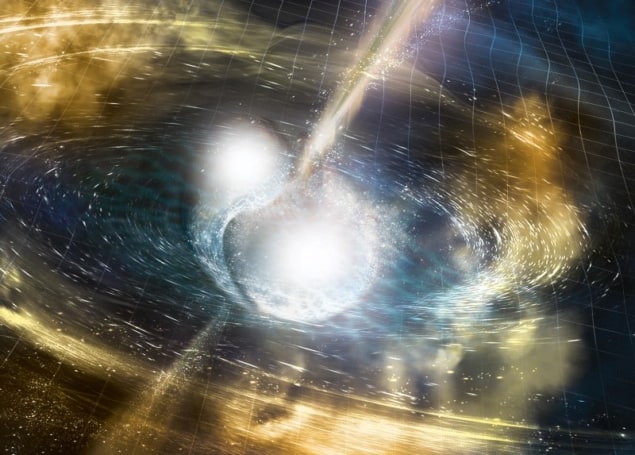
Physicists in Japan and Lithuania have found evidence that tellurium is produced in neutron star mergers. Their findings bolster the idea that neutron star mergers are responsible for most of the heavy elements in the universe.
The synthesis of heavy nuclei – those heavier than silver – is described by a set of nuclear reaction know as the “r-process” or rapid neutron-capture process. First proposed in 1957, it occurs in an environment with a large density of free neutrons, whereby nuclei begin to capture neutrons much faster than the rate at which they can beta-decay. This produces a characteristic distribution of neutron-rich nuclei, with peaks around certain atomic mass numbers such as 80, 130 and 196.
The abundance patterns in our solar system clearly show these r-process peaks, suggesting that this process is the origin of all heavy elements on Earth. It had been proposed that this process mainly occurs in “whipped-out” matter from neutron star mergers, producing an event called a kilonova – named because it is as bright as a thousand novae, yet not as bright as a supernova.
The existence of kilonovae was confirmed in 2017 when gravitational waves from a neutron-star merger called GW170817 were detected. A frantic follow-up by astronomers across the world ensued, locating a transient as bright as a billion suns in a galaxy 130 million light-years away. Its rapidly declining light curve indicated that it was powered by the radioactive decay of ejected r-process elements.
Previous studies had found absorption signatures of strontium, cerium and lanthanide elements throughout the initial spectrum of GW170817’s kilonova, while spectra taken later became dominated by emission features. The radiative properties of this “nebular” phase remained poorly understood because these conditions are difficult to replicate in experiments on Earth.
To get around this issue, researchers modelled emission lines of several heavy elements by applying certain selection rules to experimentally known energy levels. Their model predicted a strong emission line at 2.1 micrometres from a forbidden transition in doubly ionised tellurium, exactly matching a previously unexplained feature of GW170817’s spectrum (Monthly Notices of the Royal Astronomical Society 526 L155). The strength of the emission line indicates that one-thousandth of a solar mass of tellurium was produced in the kilonova.
Webb joins the fray
In a separate study, observations by the James Webb Space Telescope (JWST) provide further evidence for r-process in neutron star mergers. The observatory carried out follow-up observations of the exceptionally bright gamma-ray burst GRB230307A. JWST took infrared spectra at 29 and 61 days following the burst, which showed an uncanny similarity to GW170817, including the same 2.1 micrometre feature attributed to tellurium – indicating another kilonova (Nature).

Spectacular collision of two neutron stars observed for first time
Given that GRB230307A is a billion light-years away – nearly an order of magnitude further away than GW170817 – this feat is a testament to the sensitivity of JWST. “JWST could obtain a spectrum of the kilonova when no other telescopes could even detect it,” Andrew Levan from Radboud University Nijmegen, who led the JWST study, told Physics World.
Levan adds there is more to come when observing kilonovae with the JWST. “The ultimate goal is to unpick the full details of all the different nuclei that are being created in these mergers so we can finally fill in the origin of all the elements in the periodic table,” he says.
Kenta Hotokezaka of the University of Tokyo, who was lead author of the GW170817 study, told Physics World that they are looking forward to observing the next neutron star merger with the JWST. “We will learn much more from such observations,” he says, “for example, elemental identification in infrared, plasma conditions and the kilonova energy source.”
- SEO Powered Content & PR Distribution. Get Amplified Today.
- PlatoData.Network Vertical Generative Ai. Empower Yourself. Access Here.
- PlatoAiStream. Web3 Intelligence. Knowledge Amplified. Access Here.
- PlatoESG. Carbon, CleanTech, Energy, Environment, Solar, Waste Management. Access Here.
- PlatoHealth. Biotech and Clinical Trials Intelligence. Access Here.
- Source: https://physicsworld.com/a/evidence-found-for-the-production-of-tellurium-in-neutron-star-mergers/



